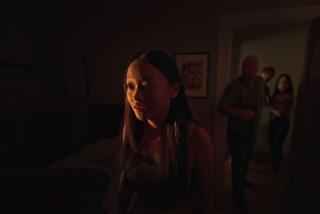Finding still life with the camera
- Share via
NEW YORK — With one notable exception, the camera in Hirokazu Kore-eda’s new film “Still Walking” never moves. What it does instead, however, is linger: over empty rooms, silent spaces and mute objects. The camera loiters, and a ghostly presence stirs -- the presence of the ineffable.
“There’s such a strong use of fixed camera in this film because I wanted the [audience] to think about the people who are actually not in the frame,” says the director, in New York on a recent promotional tour. For “Still Walking,” which opened Friday, and for Kore-eda, technique creates meditative oases of powerful, wordless testimony. Following in the wake of the critically acclaimed “After Life” and “Nobody Knows,” “Still Walking” is another Kore-eda film haunted by death: in this case, the tragic loss of oldest son Junpei, still manifest during a family gathering a decade and a half later.
The movie, most of which takes place over a single day, is carefully attuned to the form mourning has taken for the Yokoyama family: the elaborately cooked meals, the petty squabbles and carefully hoarded grievances, the annual visit by the boy whose life Junpei saved. Second son Ryo (Hiroshi Abe), in particular, is plagued by the memory of his older brother, who presents an ideal that he can never meet. “For the people who are left behind,” observes Kore-eda, “it’s a question of the presence of people who’ve passed away. What is the effect that they have on people who are still living? There is still a very strong influence that’s exercised after they’ve died.”
A literature student who had initially intended to be a novelist, Kore-eda directs films that have a novelistic bent, their stories propelled by tiny, subtle revelations of character. With “Still Walking,” the 47-year-old director was inspired in part by the recent death of his mother, although the film’s family bears little relation to his own. “About half [of the mother’s] lines are things that my own mother actually said to me, but the father character is quite different from my own father.”
It is a film of long pauses and carefully crafted answers, where silences mean as much as the words spoken. “Still Walking’s” quiet is deceptive; demons lurk beneath the veneer of politeness. Kore-eda prefers to emphasize the absences: “It’s something I like very much, the idea that there’s something left behind by people when they leave, some sort of after image.”
The camera hints at ghostly presences it does not see but can only sense. “That’s something that’s of very strong interest to me right now, personally, with my mother passing away,” Kore-eda says about the living’s enduring relationship with the dead. “She’s not really gone. Her presence, when she was living, and her absence both affect me deeply.”
Kore-eda’s 1999 film “After Life” was a gentle supernatural fantasy, its protagonists the recently deceased, assisted by a video crew to film and record a reenactment of one enduring memory from their time on Earth. “Still Walking,” like “After Life,” wonders about life after death, but the lives in question are those of the living. “Even when they die, people don’t really go away,” a mother tells her son, and the statement -- part reassurance, part curse -- is the foundation of this hushed, deceptively placid film.
The setting -- Japanese, domestic, intimate -- immediately brought past masters like Yasujiro Ozu and Mikio Naruse (“When a Woman Ascends the Stairs”) to mind for Kore-eda, but he let their influence creep only so close. “Because the subject matter is about Japanese families, Japanese home life, there are some directors such as Ozu and Naruse whose works I did reference but before I got into shooting. When I’m working actively on a film, and when I’m on set, I try not to be too conscious of or influenced by other directors’ works,” he says.
When the camera does at long last take flight in “Still Walking,” the film’s buried emotion surges heavenward along with it. The mourning process has finally come to an end, and Kore-eda has translated feeling into gloriously free motion. Having held his camera in check for so long, the director is ready for a different sort of challenge. His next film, only recently wrapped, is a fantasy called “Air Doll”: “Stylistically, it’s very different from ‘Still Walking.’ The camera is continuously moving!”
--
More to Read
Only good movies
Get the Indie Focus newsletter, Mark Olsen's weekly guide to the world of cinema.
You may occasionally receive promotional content from the Los Angeles Times.










